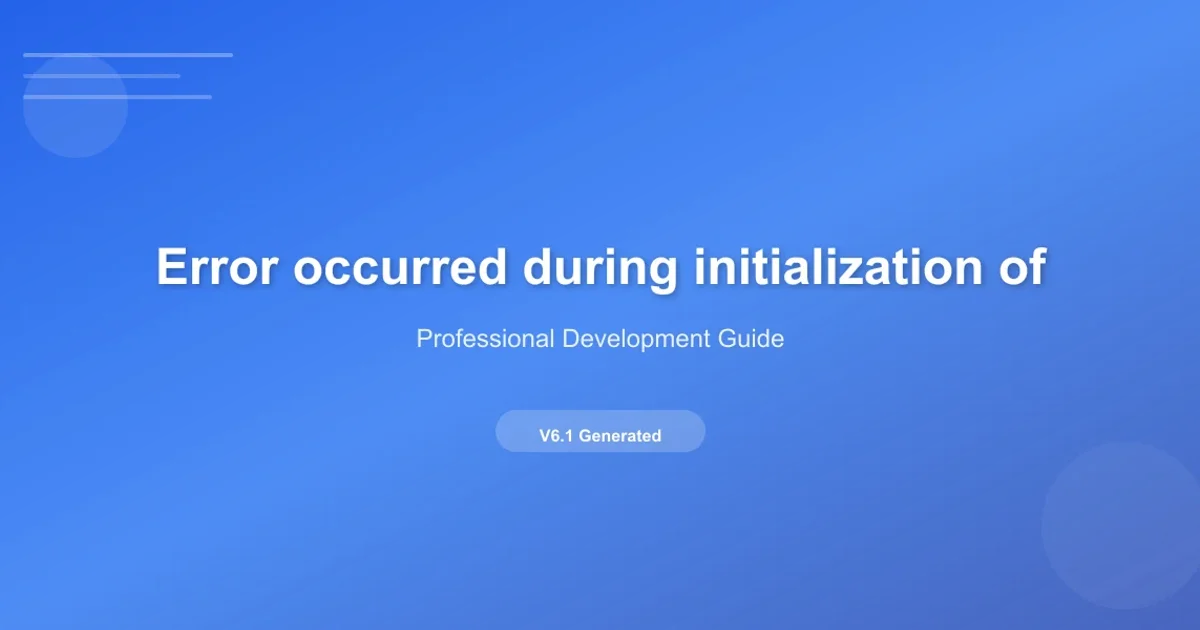Error occurred during initialization of VM Could not reserve enough space for object heap Could n...
Categories:
Troubleshooting 'Could not reserve enough space for object heap' in Java

Learn to diagnose and resolve the common Java Virtual Machine (JVM) error 'Could not reserve enough space for object heap' by adjusting memory settings and understanding system constraints.
The error message "Error occurred during initialization of VM Could not reserve enough space for object heap Could not create the Java virtual machine" is a common issue faced by Java developers and users. It indicates that the Java Virtual Machine (JVM) was unable to allocate the requested amount of memory for its heap, which is where Java objects are stored. This problem typically arises when the system lacks sufficient contiguous memory or when the requested heap size exceeds available resources. Understanding the root causes and proper configuration adjustments is key to resolving this issue.
Understanding the Java Heap and Memory Allocation
The Java heap is a crucial part of the JVM's runtime data area. It's where all class instances and arrays are allocated. When you start a Java application, you can specify the initial and maximum heap sizes using JVM arguments. The error "Could not reserve enough space for object heap" means that the operating system could not fulfill the JVM's request for a contiguous block of memory of the specified size. This can happen due to several reasons:
- Insufficient Physical RAM: Your system simply doesn't have enough free physical memory to satisfy the request.
- 32-bit JVM Limitations: On 32-bit operating systems or with a 32-bit JVM, the addressable memory space is limited (typically around 2-4 GB, depending on the OS and configuration), even if you have more physical RAM. This limit applies to the total process memory, not just the heap.
- Memory Fragmentation: Over time, memory can become fragmented, meaning there are many small blocks of free memory but no single large contiguous block available for the JVM's heap.
- Other Processes Consuming Memory: Other applications running on your system might be consuming a significant amount of memory, leaving little for the Java process.
- Incorrect JVM Arguments: You might be requesting an excessively large heap size that your system cannot provide.
flowchart TD
A[Start Java Application] --> B{JVM Memory Request (e.g., -Xmx2G)}
B --> C{Operating System Attempts Allocation}
C -->|Success| D[JVM Starts, Application Runs]
C -->|Failure: No Contiguous Space| E["Error: Could not reserve enough space for object heap"]
E --> F{Possible Causes:}
F --> F1[Insufficient RAM]
F --> F2[32-bit OS/JVM Limit]
F --> F3[Memory Fragmentation]
F --> F4[Other Processes]
F --> F5[Excessive -Xmx Value]
F --> G[Troubleshooting Steps]Flowchart illustrating the JVM memory allocation process and potential failure points.
Diagnosing and Resolving the Error
Resolving this error involves a combination of checking your system's resources and adjusting JVM memory settings. The primary solution usually revolves around the -Xmx JVM argument, which sets the maximum heap size.
Common Solutions and Configuration Examples
Here are the most common approaches to fix the 'Could not reserve enough space for object heap' error, along with practical examples.
1. Reduce the Maximum Heap Size (-Xmx)
The most straightforward solution is to reduce the maximum heap size requested by the JVM. Start by lowering the -Xmx value. For example, if you were trying to allocate 4GB (-Xmx4G), try 2GB (-Xmx2G) or even 1GB (-Xmx1G). You can gradually increase it until you find the maximum stable value for your system.
2. Increase Physical RAM or Free Up Memory
If reducing -Xmx isn't an option because your application genuinely needs more memory, consider adding more physical RAM to your system. Alternatively, close other memory-intensive applications before running your Java program to free up resources.
3. Switch to a 64-bit JVM
If you are running a 32-bit JVM on a 64-bit operating system, you are likely hitting the 32-bit process memory limit. Install a 64-bit JDK/JRE and ensure your system is configured to use it. This will allow the JVM to access much larger amounts of memory.
4. Adjust Initial Heap Size (-Xms)
While -Xmx sets the maximum, -Xms sets the initial heap size. If -Xms is set too high, it can also cause this error, especially if the system is under memory pressure at startup. It's generally recommended to set -Xms and -Xmx to the same value for performance in production environments, but for troubleshooting this specific error, you might try setting -Xms to a smaller value (e.g., -Xms512m -Xmx2G).
5. Check for Memory Leaks in Your Application
If your application gradually consumes more and more memory until it crashes, you might have a memory leak. While this error occurs at JVM initialization, a memory leak could be the underlying reason why you're constantly trying to increase the heap size. Use profiling tools like JVisualVM or YourKit to analyze heap usage.
java -Xmx1024m -jar YourApplication.jar
java -Xms512m -Xmx2g -jar AnotherApplication.jar
java -Xmx512m -version # Test with a smaller heap to see if JVM starts
Examples of setting JVM heap size arguments from the command line.
-Xmx values, use 'm' for megabytes (e.g., 512m) or 'g' for gigabytes (e.g., 2g). Always leave some memory for the operating system and other processes. A good rule of thumb is to not allocate more than 50-75% of your total physical RAM to a single JVM heap.